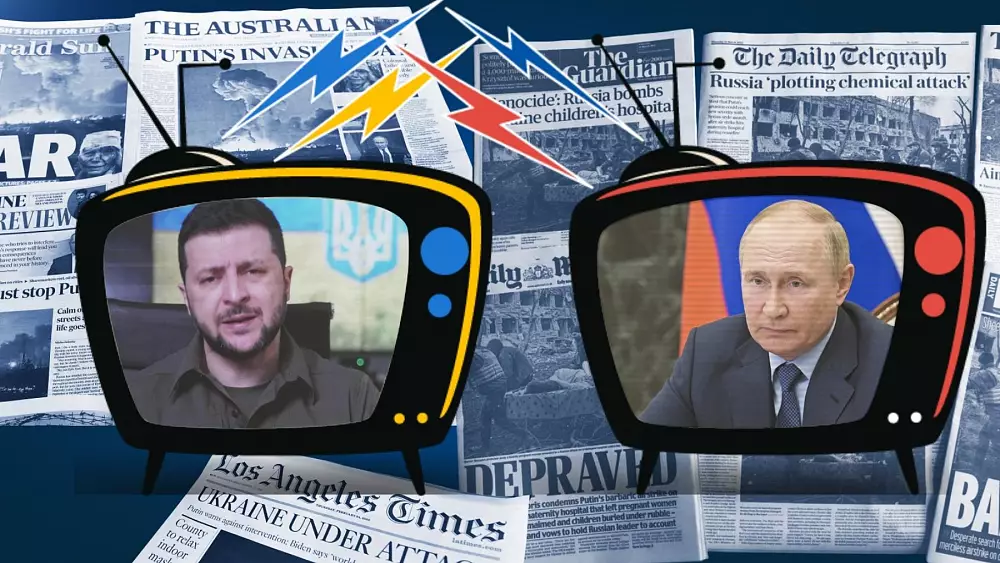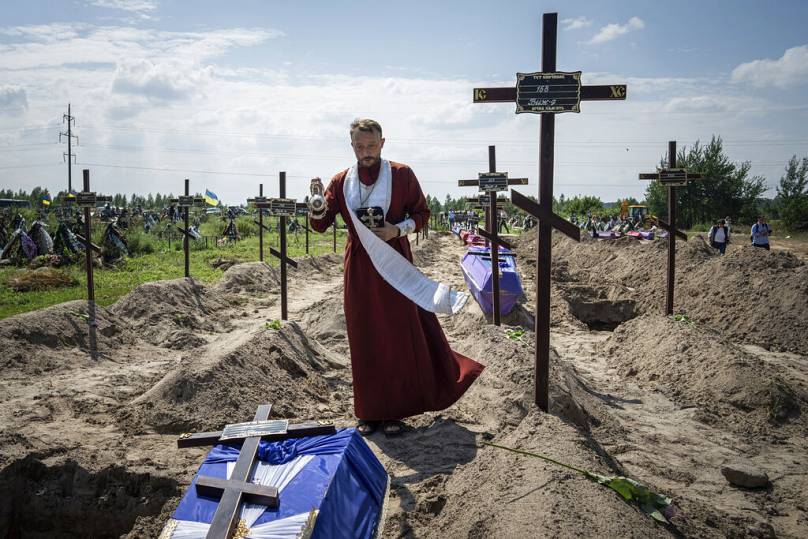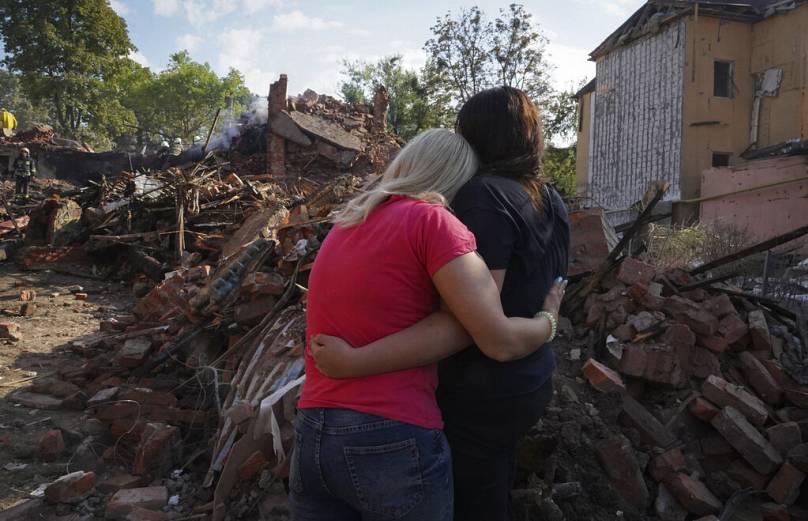At the end of February, as Russian forces poured into Ukraine, so did the international news media.
For weeks after the invasion, millions of people around the globe watched events unfold, hosted live and direct from Kyiv or Lviv by the familiar news anchors they were used to seeing in a comfortable studio.
After a while, those presenters relocated back to their home countries and reporters on balconies or rooftops gave the latest updates, sometimes with colleagues in the field newsgathering for video packages – regularly putting themselves in grave danger in extreme conditions to make sure the world knew about was happening in the war.
But then things changed. An election came up. Or a celebrity scandal. A budget crisis or a natural disaster. Whatever it was in your country, it knocked the war in Ukraine off the front pages of newspapers, relegated the video to a later time slot in the news bulletin, or consigned the text further down your digital news source.
That’s how Ukraine war coverage fatigue sets in: by attrition and by necessity, rather than by design.
“It happens with any news coverage of major events, particularly with explosive news and things that are traumatic,” said Steinar Ellingsen, a Norwegian who lectures in journalism at the University of Wollongong in Australia, and who has studied the news fatigue phenomenon.
“I think there’s a pattern when the new cycle moves on after the first wave, and then particularly the further geographically away from the conflict you are, the quicker the interest pales. With distance, time and resources, and budgets drain very quickly,” Ellingsen told Euronews.
A sense of fatigue for any particular story, however, is a two-way street. While audiences can grow tired of seeing the same topic night after night on the evening news, or seeing it plastered on the front page of their newspapers every day, newsrooms themselves can get bogged down with any single topic.
For most media organisations that sent journalists into Ukraine, it was an expense which hadn’t been budgeted for, and that can influence other news coverage decisions as well, like potentially having to scale back on reporting of important domestic events because money became tight.
Experience: Sweden’s Expressen newspaper
In their Stockholm newsroom, Expressen editors are already two decades into a digital journalism revolution which means they can be very responsive when it comes to what sort of news their audiences are consuming.
With 5.5 million visitors to their site each week, managers at Expressen know precisely what content is being read.
“I think the public and the media only has room for one big story at a time. So four or five years ago people were talking about immigrants, then Greta Thunberg and the climate crisis, then Coronavirus, and after that, here in Sweden, it was crime shootings, then the invasion of Ukraine,” said Expressen’s managing editor Magnus Alselind.
“With the digital revolution, the attention span for the public is very short and very intense,” he told Euronews.
Still, Swedish media outlets, including Expressen, have been very proactive in covering events in Ukraine, and were there before and during the Russian invasion.
“We had a constant presence from when it happened all the way into the summer. We had two reporting teams, sometimes even three teams in the area for the first weeks and months. It was very intense, for us and other newspapers too, it was a massive effort,” said Alselind.
That has changed for now, with the attention of Sweden’s media outlets shifting firmly since Midsummer to September’s general election.
Older audiences, explained Alselind, are still very interested in developments in Ukraine, so the conflict is featured prominently in traditional print editions of newspapers. But for digital audiences, the interest has waned.
Although there are no Expressen journalists currently on assignment to Ukraine, the newspaper has plans to send them back in the coming months, after the election.
Experience: Finland’s Helsingin Sanomat newspaper
With 400,000 subscribers, Helsingin Sanomat sets the news agenda for Finland and is the “newspaper of record” in the Nordic nation.
The coverage of Russia’s war in Ukraine grew its audience at the start of the conflict, although that has fallen back a little over time.
“But we can see from the analytics of foreign news that we have more visitors and interest than before the war, and interest is still high even if it is a bit down from the peak,” explained Virve Kähkönen, Helsingin Sanomat’s foreign editor.
The paper still has a live blog where they find people dip in to get a snapshot of the latest news, and throughout the last six months, there have been regular teams of journalists going from Helsinki to Ukraine to report on events from inside the country.
“We don’t have anyone there permanently, but we have been rotating people. We had journalists all the time in the spring when the war began, and even before that, and in the summer we had a short break but now we have teams on the ground again and planning to send journalists for the rest of the year,” Kähkönen told Euronews.
For Finnish audiences, the type of news they are interested in has changed as well. Now, there’s more focus on understanding Russia’s motivations and reactions – and it helps that Helsingin Sanomat and other Finnish media outlets have traditionally always had a Moscow correspondent, as well as regular freelancers in other parts of Russia.
“The focus is now more in Russia, as Finnish readers are very interested in what happens in Russia, and what Russian people are thinking about the war; or how Western sanctions have impacted Russian lives,” said Virve Kähkönen.
For example, one of the newspaper’s biggest stories this summer was about Russian holidaymakers who travelled to Sochi because they couldn’t go on foreign holidays due to sanctions.
“There’s less interest in refugee stories or Ukrainian suffering which is sad of course, but those kind of stories don’t interest our readers so much anymore. People are now more interested in Putin’s motives and his ideology,” she explained.
“But of course, Russia has always been very interesting for Finnish audiences.”
How can newsrooms reverse the trend in fatigue?
Once news fatigue sets in for any particular subject, is it possible to then reverse the trend?
It can happen for significant new events: in the case of a war, it might take a spectacular development, an atrocity, a major advance, or when a key city falls or is recaptured.
But journalism lecturer Steinar Ellingsen explained there’s research showing how audiences tend to “binge” initial coverage but then become inured as it goes on.
“The drop-off is notable because it’s too overwhelming, and by that time the news has already established that things are dire. Sometimes a media strategy, when something starts to fade, is to give it more coverage, more details, but that’s not always successful.”
One common strategy is to start relating the issues in Ukraine for example, with local issues facing the newspaper’s readers, or the television channel’s viewers: like why are there rising food prices or increased fuel costs, and how can that all be traced back to the main story that is happening in Ukraine?
“It’s what average news consumers really want to know,” says Ellingsen. “Beyond the increasing death toll, or the disaster of war.”














